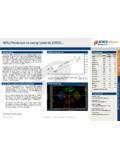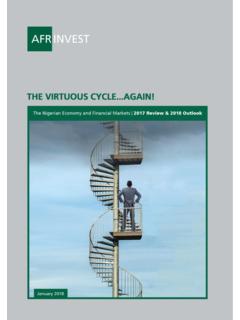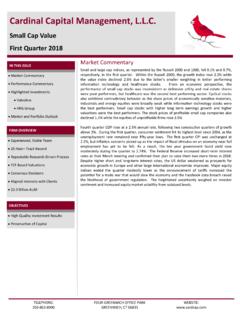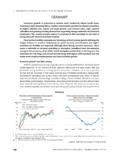Transcription of TURKEY - OECD.org
1 3. DEVELOPMENTS IN INDIVIDUAL OECD AND SELECTED NON-MEMBER ECONOMIESOECD ECONOMIC OUTLOOK, VOLUME 2018 ISSUE1 PRELIMINARY VERSION OECD 2018230 TURKEYF ollowing a strong recovery in 2017 and turbulence in spring 2018, economic growthis set to slow but to stay around 5% in 2018 and 2019. The uncertainties surrounding theearly elections in June, as well as persisting regional geopolitical tensions, create exchange rate remains highly volatile, with the lira depreciating substantiallyrecently despite a significant increase in the policy interest rate, and consumer priceinflation is far above target. Disinflation is projected to be credible macroeconomic framework is of utmost importance to uphold confidencein this sensitive environment. The Medium-Term Economic Programme provides aprudent fiscal framework, and recent monetary tightening should be backed withstronger institutional credibility of monetary policy.
2 Structural reforms to align thebusiness environment with international good practices should be stepped up as soonas possible to rebalance growth and make it more has been backed by strong exports and government supportReal GDP growth in 2017 and early 2018 exceeded both market expectations andofficial projections. Robust foreign demand and real exchange rate depreciation havesupported exports. Fiscal and quasi-fiscal stimulus, including a massive extension of thegovernment credit guarantee scheme, have boosted domestic demand. Stimulated by newemployment incentives, million net new jobs were created in 2017, but strong labourforce growth kept unemployment close to 10% as of early 2018. Private investment wassubdued over most of the recent period, reflecting wait and see attitudes of investorsamid various domestic, regional and international uncertainties.
3 Yet, on the back ofbrightening export prospects and hefty government incentives, investment picked up inlate 2017 and the share of machinery and transport equipment investment in GDP returnedto its long-term average of around 13%, one of the highest rates in the Three-quarter moving :OECD Economic Outlook 103 database ; and Thomson 2 4 20246810121405102014201520162017Y o y % changes Real GDPReal private consumptionReal exports of goods and servicesStrong growth is driven by exports010020030040005010015020025030035 04004502014201520162017 Basis pointTurkeyChilePolandEMBI spreadsRisk perceptions have deteriorated3. DEVELOPMENTS IN INDIVIDUAL OECD AND SELECTED NON-MEMBER ECONOMIESOECD ECONOMIC OUTLOOK, VOLUME 2018 ISSUE1 PRELIMINARY VERSION OECD 2018231 Increased imbalances and uncertainties call for a credible macroeconomic frameworkStrong growth has amplified TURKEY s longstanding imbalances, which arise fromexcessive reliance on domestic demand.
4 The current account deficit is estimated to havesurpassed 6% of GDP in early 2018 and foreign financing needs are projected to reach 25%of GDP in 2018. Oil price increases have put additional pressure on the current account andexternal funding will become less abundant and more costly as advanced OECD economiesnormalise monetary policy. Fiscal policy has added to the imbalances. Spending pressuresincreased strongly in spring 2018, owing to new business incentives and further socialtransfers. Early elections in June 2018 create room for post-electoral consolidation in linewith the government's Medium-Term Economic Programme. The fiscal position should bereported fully and transparently, with timely quarterly general government accountsaccording to international commitment of the central bank to the official 5% inflation target is in questionafter several years of overshooting and five consecutive quarters of double-digit exacerbated exchange-rate depreciation and volatility, considerably increased thecountry's risk premia, and heightened risks associated with external debt.
5 Against thisbackdrop, the central bank increased its lending rate by a cumulative 375 basis points inApril and May this year. To strengthen monetary policy credibility, the commitment to thecentral bank's independence and to the inflation target should be reinforced. Monetarypolicy should be simplified, and forward guidance should be provided on how theauthorities plan to hit the 5% inflation target in the foreseeable :Demand, output and prices1 2 prices TRY billion GDP at market prices2 Private consumption1 Government consumption Gross fixed capital formation Final domestic demand2 Stockbuilding1 Total domestic demand2 Exports of goods and services Imports of goods and services Net exports1- Memorandum itemsGDP deflator Consumer price index Core inflation index2 Unemployment rate (% of labour force) Current account balance (% of GDP) 1.
6 Contributions to changes in real GDP, actual amount in the first column. 2. Consumer price index excluding food and energy. Source: OECD Economic Outlook 103 database. Percentage changes, volume (2009 prices)3. DEVELOPMENTS IN INDIVIDUAL OECD AND SELECTED NON-MEMBER ECONOMIESOECD ECONOMIC OUTLOOK, VOLUME 2018 ISSUE1 PRELIMINARY VERSION OECD 2018232 Growth is set to slow and could further decline if tensions intensifyOn the back of strong positive carry-over from late 2017 and early 2018, absent anyfurther severe tensions on exchange rates and risk premia, and assuming no newdisturbances in international capital flows as advanced economies normalise economicpolicies, GDP growth is projected to stay around 5% in 2018 and 2019.
7 If the electoralprocess concludes without major tensions, fiscal and monetary policies do not remainpro-cyclical, and ambitious but delayed structural reforms are phased in after theelections, consumer and investor sentiment may improve and growth may be stronger. Ifconfidence weakens following additional uncertainties regarding the macroeconomicpolicy stance or the outlook for structural reform after the elections, or as a result offurther tensions in financial markets and exchange rates, capital movements anddomestic sentiment may weaken investment, consumption and growth.

















